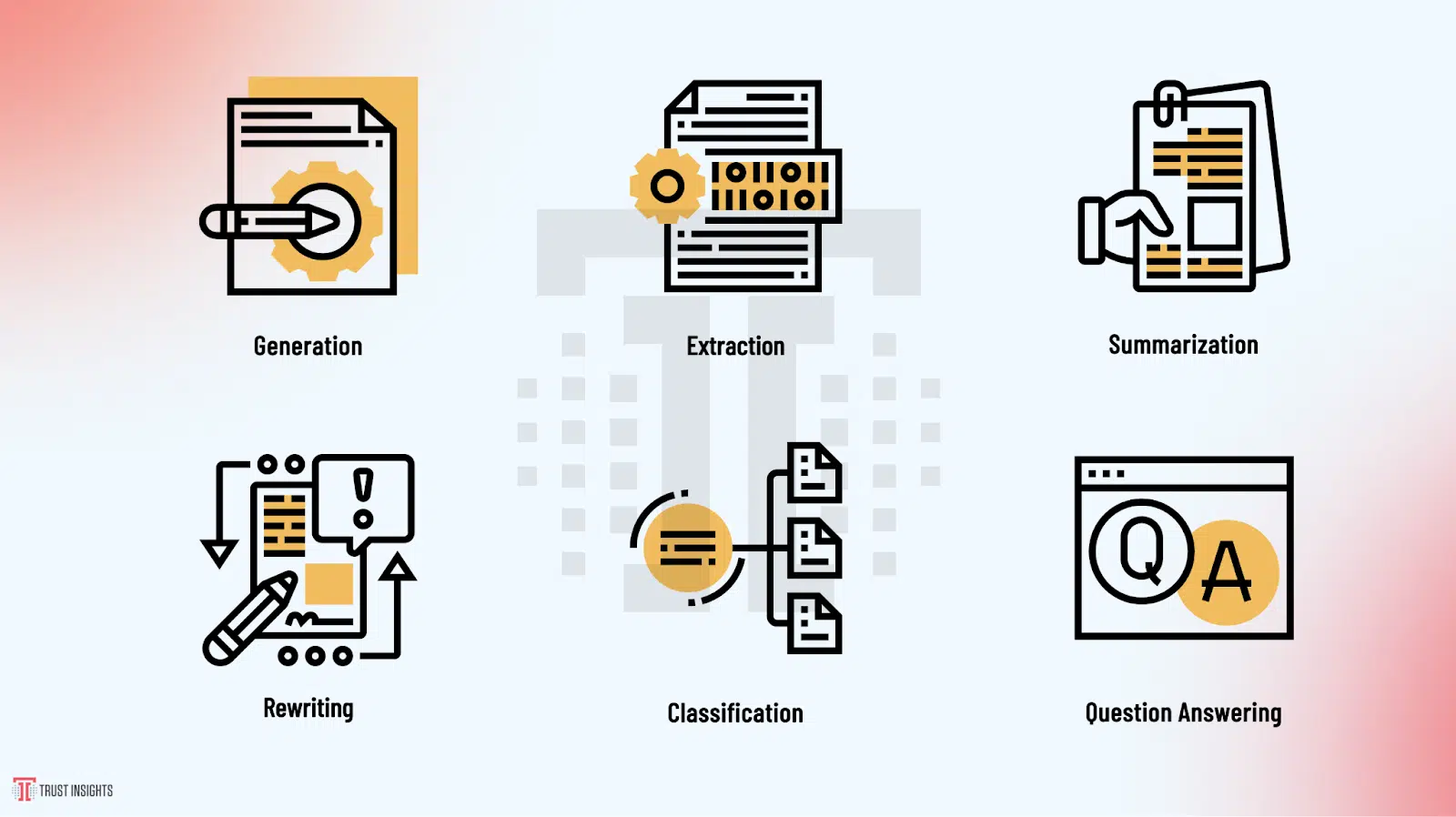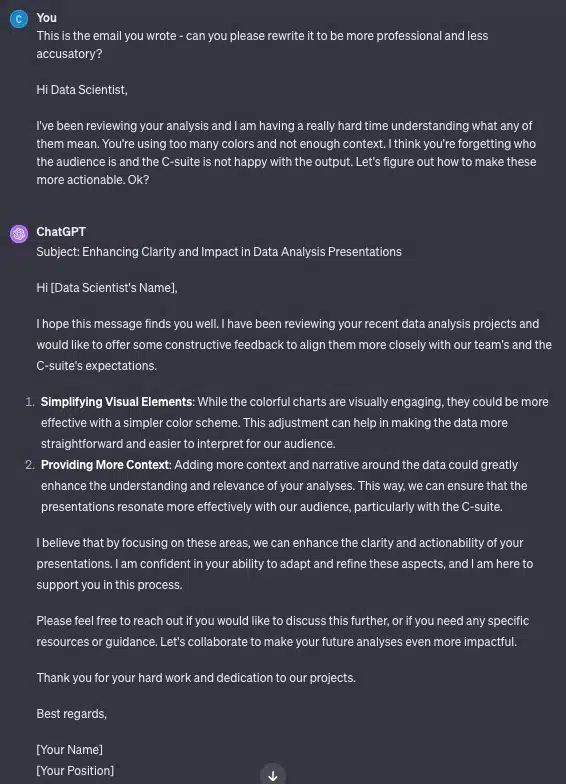6 ways to use generative AI for your marketing
Learn capabilities, use cases and ethical considerations as you integrate generative AI into your marketing strategy.
Generative AI is revolutionizing digital marketing by altering how we create, analyze and optimize marketing strategies. This technology leverages artificial intelligence for tasks like content creation, data analysis and customer engagement.
Understanding and harnessing its capabilities allows marketers to achieve new levels of efficiency and creativity. This article explores six types of AI use cases in marketing, each offering a unique contribution.
The components of genAI
First, let’s examine the components that constitute generative artificial intelligence. These can be easily remembered with the acronym “FOG,” which stands for find, organize and generate.
Find
Artificial intelligence requires data to function effectively. This data can come from external sources or be uploaded by users. Systems like ChatGPT use publicly available data, enhanced with user-provided data. Custom GPT models are now available, where the database is solely user-provided data.
Each system has its pros and cons.
- A generative AI system makes a broader variety of data accessible, but the accuracy must be verified.
- Custom GPT models offer controlled data but are limited to what is provided.
Organize
Next, the system must organize the data. It should be structured for easy access as needed, like organizing papers in file folders — alphabetically, chronologically or by topic. Your AI system should do the same, ensuring quick and efficient access for creating outputs.
Generate
This is of particular interest to marketers. “Generate” doesn’t only refer to creating new content but encompasses various capabilities. There are six classifications for use cases: generate, extract, summarize, rewrite, classify and question and answer.
The next step is maximizing the potential of the system in use. Crafting an effective prompt is crucial. Whether generating or rewriting content, specificity is key. One approach is RACE, which stands:
- Role: Defines who you need the system to be.
- Action: Specifies what the system should do.
- Context: Involves providing additional information.
- Execution: Reiterates the action with specific outcomes.
Below are examples of effective prompts:
- You are a content marketer. Create an outline for the six ways to use generative AI in marketing, covering generation, extraction, classification, summarization, rewriting and question and answer. The outline should be casual yet informative, formatted for editing in a Word document.
- You are a data analyst. Analyze the provided Google Analytics channel data to identify audience origins and the most effective channels. Extract actionable insights for the marketing manager’s budgeting. Include a chart of the data.
Dig deeper: Third-party data in advertising: Best of the MarTechBot
6 classifications of genAI use cases

1. Generation: Creating content
Most marketers use generative AI to create brand-new content. Generative AI is adept at this task, but quality and uniqueness depend on user guidance.
Initially, there were concerns that AI-generated content would rank lower in search engines. However, Google has clarified that using AI for content creation is not against their guidelines:
Will AI content rank highly on Search?
Using AI doesn’t give content any special gains. It’s just content. If it is useful, helpful, original and satisfies aspects of E-E-A-T, it might do well in Search. If it doesn’t, it might not.
Google Search Central
Up to 64.7% of CMOs stated that they would use generative AI to create blogs, and 62.2% will use it for other website content, according to the Fall 2023 CMO Survey.
When using generative AI for new content, enter the process with strong ideas, specific examples and a unique perspective. The system writes the content, but you ensure its quality and value to the end user.
Dig deeper: Working with text generators: A marketer’s guide to AI
2. Extraction: Gleaning insights from data
Extraction, a less-utilized use case, allows generative AI to perform preliminary data analysis. Generative AI can assist in extracting insights using techniques like sentiment analysis, trend identification and regression analysis.
For instance, our recent survey required organizing and analyzing text string responses. In under 30 minutes, our AI system provided a basic analysis of topics, themes and next steps. The basic process involved uploading the data to the system, prompting it to analyze the data and then iterating through questions.
You can also use generative AI to extract data. Consider the various market research reports (like the CMO Survey) we use and cite. With the assistance of generative AI, you can extract charts and other data more easily for use in your research and reporting.
3. Summarization: Condensing information for clarity
Generative AI can quickly summarize large volumes of data, such as academic papers and market research. This capability is useful for creating concise summaries that highlight key trends and findings.
It can also summarize your analyses and presentations into executive summaries for easy sharing. Gone are the days of sitting in front of lengthy reports and wondering, “What the heck is this even about?”
4. Rewriting: Refining messages for impact
Generative AI excels at rewriting content. It can modify content for different audiences and platforms, ensuring relevant communication. If you struggle to articulate your message, generative AI can help rewrite it in a professional tone.

Generative AI is also valuable for creating content variations, like ad copy. Upload a post, and the generative AI can identify areas for expansion, reduction or updating and then revise accordingly.
You can quickly come up with hundreds of variations of your copy with a few keystrokes. Like with any other generative AI use case, rewriting requires human supervision. These systems can misinterpret meaning and tone, making your rewrite less effective than the original draft.
Dig deeper: AI in marketing: How to balance automation and the human touch
5. Classification: Organizing data for better understanding
When set up correctly, generative AI can efficiently categorize market and customer data, aiding in personalized marketing campaign development. For instance, it can classify customers based on purchasing behavior, enabling targeted email campaigns for higher engagement and conversion rates.
Personalizing content to your audience’s journey enhances receptivity, and AI can help classify content for this purpose. You likely already have your sales content created. Now, you can use generative AI to ensure it’s getting to the right audience at the right time.
6. Question answering: Enhancing customer engagement and support
Question answering is not a new innovation of generative AI. However, you can now create more in-depth systems for your customers to interact with and more easily keep the information up to date.
Generative AI-driven question-answering systems enhance customer service by providing instant, accurate responses to inquiries. Just like automating intake forms at a doctor’s office, you can use question-answering to expedite the data-gathering process. This means that you spend your time more valuably when talking with a customer. This capability improves customer satisfaction and frees human resources for more complex tasks.
Using genAI in your marketing efforts
Generative AI is an excellent supplement to marketing but shouldn’t be the sole focus. As the technology and expectations evolve, the need for human oversight remains. Integrating generative AI into marketing ensures your business requirements cover intent and measurable outcomes.
Integrating generative AI in marketing offers a range of benefits, from creative content generation to nuanced customer insights. Ethical considerations and a commitment to continuous learning and adaptation are vital as we embrace these technologies. The potential for AI to revolutionize marketing is immense, and its informed application can lead to significant advancements in the field.
Opinions expressed in this article are those of the guest author and not necessarily MarTech. Staff authors are listed here.
Related stories